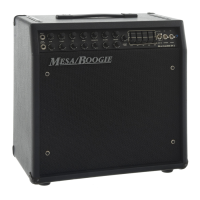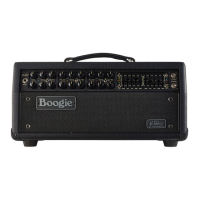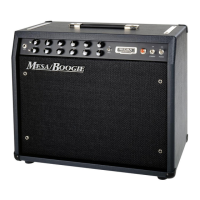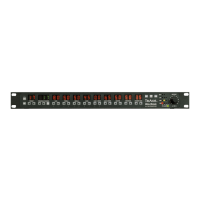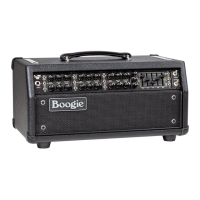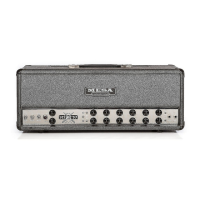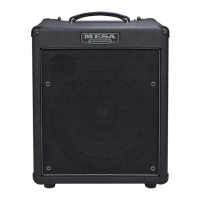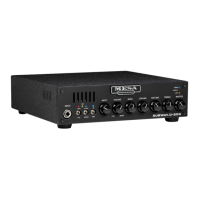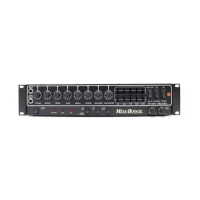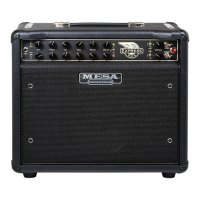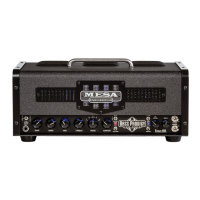common sense approach; as GAIN goes up - BASS should come down, you’ll find great sounds easily and quickly.
Example:
• With the GAIN at 12:00 – BASS at 1:00
• With the GAIN at 1:00 – BASS at 12:00
• With the GAIN at 2:00 – BASS at 11:00
Again, this is just to give you a rough example of the concept. The offset differences might be greater than this or less, depending on
guitar, speaker cabinet, room, live pics on stage, outdoors vs. indoors, etc.
And finally, the nice thing about the BASS control is that it is the least affected by other controls and really the GAIN is the only control
you will need to consider with it as far as avoiding less than optimum sounds. Unlike the TREBLE, MID and PRESENCE, which share
the top end duties across a wide spectrum from really high midrange all the way to the harmonic region far above that the TREBLE
affects, the BASS is a one stop shop in terms of dialing in rich low end.
PRESENCE
This control adjusts high frequencies above those of the TREBLE and is farther downstream in the signal path
than the standard Tone Controls and located in the power section. You can think of the PRESENCE as a control that allows you to
either clamp the highs down in the power amp, compressing and darkening things - or open it up and let the full spectrum of upper
harmonics come chiming through. It also has a great deal to do with how dynamic the signal is and how a sound will cut through
the mix in an ensemble environment.
At low settings (7:30 – 10:30) the sound will be warm and round with a more compressed feel and dynamic attack, especially in the
upper frequencies that add urgency, will be limited. As the PRESENCE is increased (11:00 – 2:30), the top end starts to become
more dominant and that compression gives way to “cut” and dynamic peaks jump out with startling speed and accuracy. At the top
end of the control (2:30 – 5:30), a super aggressive blend of upper harmonics dominate the sound and this region can be somewhat
dangerous if it’s not applied in small measures. Higher notes will slice and dice even the bravest set of ears and we suggest using
this region mostly in the studio for recording where the sound can be isolated and dealt with in context. Even then, it may find it’s most
appropriate applications on parts that feature the lower strings. This highest region – especially when coupled with the inherent curve
of many of the microphones typically used in P.A. (sound reinforcement) applications, can be truly punishing in the wrong hands, so
be cautious and courteous to your bandmates and audience and dial with care.
Clean sounds can generally benefit from a bit higher PRESENCE settings (10:30 – 12:30) than sounds that have overdrive involved
in their makeup. Once saturation begins, the frequencies carried in the PRESENCE control can make things edgy or brittle… even
buzzy, real fast if you aren’t careful. Overdriven chording sounds can tolerate higher settings (10:30 – 12:30) better than can single
note sounds, which usually want to roam the zone below 11:00 to stay round, focused and vocal.
NOTE: As mentioned earlier, the entire top end spectrum is shared among the TREBLE, MID and PRESENCE, each having its own
region, power (effectiveness) and character in the overall signature of the top end. So when dialing in your sounds make sure to use
all three of these controls to balance the different frequencies.
MASTER
This control determines the overall output level and is located at the very end of the preamp. By using it in combina-
tion with the GAIN control, any amount of preamp signal strength – gain – (within the California Tweed’s traditionally-oriented gain
parameters) can be achieved at any playing volume. Once you have dedicated the GAIN control to the desired type of sound, clean
or overdriven, you can then balance the volume level using the MASTER control.
In addition, the MASTER, along with the setting of the GAIN control way upstream, functions as an EFFECTS SEND level control
for the EFFECTS LOOP. The levels have been optimized at the SEND to accommodate the widest range of great usable sounds, so
you will never likely know all the trouble we go to to make sure not only do these elements work seamlessly to protect the integrity of
your Tone WITHOUT using the Loop, you can rest assured your processors will interface nicely without compromising it. However,
please remember that EVERYTHING in the signal path is a “Tone element”, so keep that in mind when choosing processors to place
PAGE 8
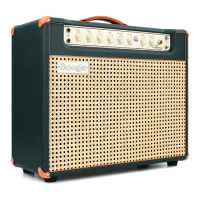
